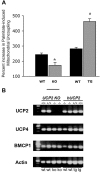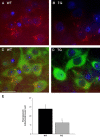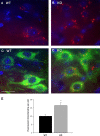Uncoupling protein-2 is critical for nigral dopamine cell survival in a mouse model of Parkinson's disease
- PMID: 15634780
- PMCID: PMC6725213
- DOI: 10.1523/JNEUROSCI.4269-04.2005
Uncoupling protein-2 is critical for nigral dopamine cell survival in a mouse model of Parkinson's disease
Erratum in
- J Neurosci. 2005 Feb 23;25(8):table of contents
Abstract
Mitochondrial uncoupling proteins dissociate ATP synthesis from oxygen consumption in mitochondria and suppress free-radical production. We show that genetic manipulation of uncoupling protein-2 (UCP2) directly affects substantia nigra dopamine cell function. Overexpression of UCP2 increases mitochondrial uncoupling, whereas deletion of UCP2 reduces uncoupling in the substantia nigra-ventral tegmental area. Overexpression of UCP2 decreased reactive oxygen species (ROS) production, which was measured using dihydroethidium because it is specifically oxidized to fluorescent ethidium by the superoxide anion, whereas mice lacking UCP2 exhibited increased ROS relative to wild-type controls. Unbiased electron microscopic analysis revealed that the elevation of in situ mitochondrial ROS production in UCP2 knock-out mice was inversely correlated with mitochondria number in dopamine neurons. Lack of UCP2 increased the sensitivity of dopamine neurons to 1-methyl-4-phenyl-1,2,5,6 tetrahydropyridine (MPTP), whereas UCP2 overexpression decreased MPTP-induced nigral dopamine cell loss. The present results expose the critical importance of UCP2 in normal nigral dopamine cell metabolism and offer a novel therapeutic target, UCP2, for the prevention/treatment of Parkinson's disease.
Figures






References
-
- Alleva R, Tomasetti M, Andera L, Gellert N, Borghi B, Weber C, Murphy MP, Neuzil J (2001) Coenzyme Q blocks biochemical but not receptor-mediated apoptosis by increasing mitochondrial antioxidant protection. FEBS Lett 503: 46-50. - PubMed
-
- Arsenijevic D, Onuma H, Pecqueur C, Raimbault S, Manning BS, Miroux B, Couplan E, Alves-Guerra MC, Goubern M, Surwit R, Bouillaud F, Richard D, Collins S, Ricquier D (2000) Disruption of the uncoupling protein-2 gene in mice reveals a role in immunity and reactive oxygen species production. Nat Genet 26: 435-439. - PubMed
-
- Beal MF, Matthews RT, Tieleman A, Shults CW (1998) Coenzyme Q10 attenuates the 1-methyl-4-phenyl-1,2,3, tetrahydropyridine (MPTP) induced loss of striatal dopamine and dopaminergic axons in aged mice. Brain Res 783: 109-114. - PubMed
-
- Bechmann I, Diano S, Warden CH, Bartfai T, Nitsch R, Horvath TL (2002) Brain mitochondrial uncoupling protein 2 (UCP2): a protective stress signal in neuronal injury. Biochem Pharmacol 64: 363-367. - PubMed
Publication types
MeSH terms
Substances
Grants and funding
LinkOut - more resources
Full Text Sources
Other Literature Sources
Molecular Biology Databases
